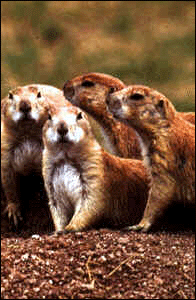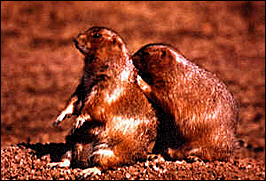|


GRASSLANDS NATIONAL PARK - With all the "kissing", hugging and grooming going on in a prairie dog town it might seem as though these cute creatures do not have a care in the world. That's not the case, of course; black-tailed prairie dogs are a favorite dish for many a furred and feathered predator. But they're also the beneficiaries of one of the most highly-evolved systems of communal defence in the animal kingdom.
When a "dog" serving sentry duty spots an intruder, for instance, he barks a signal to warn others. Recent research suggests prairie dogs can even specify the particular type of predator, whether hawk, badger or weasel, and whether the predator threatens immediate family or neighbours.
 |
| - courtesy U.S. Parks Service |
| Black-tailed prairie dogs depend on each other for
survival. |
If the threat proves serious enough to force the dogs underground, the sentry monitors developments overhead from a "listening room" near the entrance to his burrow, typically five metres (15 feet) deep. When the coast is clear, he stands upright on the volcano-like mound surrounding his entrance and issues a series of "jump-yips", "all clear" signals delivered while flipping his front legs into the air and jumping straight up off his hind ones. The effect is an amusing gesture not unlike an excited person doing the wave at a sporting event.
Kissing and hugging are actually defensive measures, too. By touching their teeth together, prairie dogs identify members of their family, or coterie. They're highly sociable creatures, but the well-being of immediate family takes priority over that of the neighbours.
 |
| - courtesy U.S. Parks Service |
| The highly sociable creatures can often been seen
grooming each other. |
"(Prairie dogs) pay a price for being communal," explains Grasslands biologist Pat Fargey. "The advantage is community vigilance, but there's more competition for food."
The family unit for a prairie dog is unusual not only by human standards, but even compared to its cousin, the ground squirrel.
"In ground squirrels a family unit is a female and her young," says Fargey. "In prairie dogs, you'll get two sisters sharing burrow systems and communally defending that space."
Community vigilance worked well for much of the prairie dog's tenure on Earth. One dog town in west Texas grew to be 100 miles wide and 250 miles long, with an estimated 400 million residents. Like 99 per cent of the prairie dog habitat in North America, the vast majority of it in the United States, that Texas colony is long gone.
Government-funded poisoning programs, land development, disease, ranchers concerned about competition for forage and sport shooters reduced U.S. populations to the point where the black-tailed prairie dog in 2000 warranted listing as a threatened species. The only reason it was not listed is that other creatures required more urgent attention, and the controversial American listing process is costly.
Saskatchewan's 20 to 25 black-tailed prairie dog colonies, the only prairie dog communities in Canada, account for less than one per cent of the range-wide population of dogs in North America. (Four other species of prairie dog, also found only in North America, are much less common than the black-tail.) About half of Saskatchewan's colonies are located within the boundaries of Grasslands National Park and all sit within in a relatively tiny area of the Frenchman River Valley and its adjacent uplands.
Under Canadian criteria the dog is listed as "vulnerable", which means it's of special concern because it is very sensitive to human activities or natural events. Prairie dog numbers in Saskatchewan are actually trending upwards since the animal gained protection here in the early 1980s. But its future is far from guaranteed.
"They're in such an extremely limited little pocket of the country that one catastrophic event, like a tremendous hailstorm or flood, could eliminate the prairie dogs," says Wayne Harris, a wildlife ecologist with the Saskatchewan government.
Disease is another concern, says Harris. Although it's not yet been a problem in Canada, sylvatic plague in the U.S. has "literally eliminated" entire communities of prairie dogs, he says. (Sylvatic plague, the name given to plague affecting wildlife, can be transmitted to humans but occurrences are rare and almost never fatal.) Biologists suspect outbreaks of sylvatic plague in the U.S. today may be the primary cause of declining prairie dog numbers in that country.
Losing the prairie dog would be bad enough. But his demise would have repercussions for other creatures, as well. The steep decline of the black-footed ferret, North America's most endangered mammal, mirrors the decline in the prairie dog because the latter is a main staple for the ferret. The ferret was extirpated from Saskatchewan, or made extinct within the region, in 1978.
 |
| - courtesy B.K. Jeffery |
| Burrowing owls use deserted prairie dog burrows for
dens. |
A total of nine prairie species are dependent upon prairie dogs, including the swift fox, ferruginous hawk, burrowing owl and the golden eagle, according to the U.S. National Wildlife Service. The swift fox has been re-introduced in the Grasslands region. The ferruginous hawk and burrowing owl are, respectively, threatened and endangered in Canada, while the golden eagle has not been categorized here. An additional 20 species opportunistically take advantage of prairie dog colonies.
In total, 117 species have some relationship with the prairie dog.
"That's why they're called a keystone species," says Harris. "A whole range of other species rely on them for a portion of their life."
Contact Us
| Contents |
Advertising
| Archives
| Maps
| Events | Search |
Prints 'n Posters | Lodging
Assistance | Golf |
Fishing |
Parks |
Privacy |
Support VS |
© Copyright (1997-2012) Virtual Saskatchewan
|

